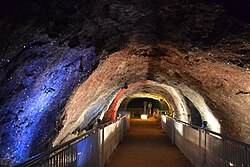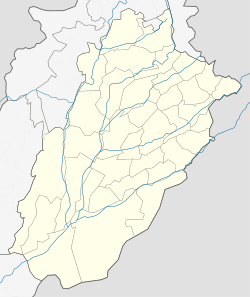Khewra Mine

Khewra Salt Mine tunnel (Crystal Valley)
|
|
| Location | |
|---|---|
| Location | Khewra |
| Province | Punjab |
| Country | Pakistan |
| Coordinates | 32°38′52.58″N 73°00′30.22″E / 32.6479389°N 73.0083944°ECoordinates: 32°38′52.58″N 73°00′30.22″E / 32.6479389°N 73.0083944°E |
| Production | |
| Products | Rock salt, Brine |
| History | |
| Opened | 1872 |
| Active | 140 years |
| Owner | |
| Company | Pakistan Mineral Development Corporation |
| Website | Khewra Salt Mines |
The Khewra Salt Mine (or Mayo Salt Mine) is located in Khewra, north of Pind Dadan Khan, an administrative subdivision of Jhelum District, Punjab Region, Pakistan, which rises from the Indo-Gangetic Plain. It is Pakistan's largest and oldest salt mine and the world's second largest. It is a major tourist attraction, drawing up to 250,000 visitors a year. Its history dates back to its discovery by Alexander's troops in 320 BC, but it started trading in the Mughal era. The main tunnel at ground level was developed by Dr. H. Warth, a mining engineer, in 1872 during British rule. After independence, the Pakistan Mineral Development Corporation took over the mine, which still remains the largest source of salt in the country, producing more than 350,000 tons per annum of about 99% pure halite. Estimates of the reserves of salt in the mine vary from 82 million tons to 600 million tons.
The Khewra Salt Mine is also known as Mayo Salt Mine, in honour of Lord Mayo, who visited it as Viceroy of India. The mine is a part of a salt range that originated about 800 million years ago, when evaporation of a shallow sea followed by geological movement formed a salt range that stretched for about 300 kilometers (185 miles).
The salt reserves at Khewra were discovered when Alexander the Great crossed the Jhelum and Mianwali region during his Indian campaign. The mine was discovered, however, not by Alexander, nor by his allies, but by his army's horses, when they were found licking the stones. Ailing horses of his army also recovered after licking the rock salt stones. During the Mughal era the salt was traded in various markets, as far away as Central Asia. On the downfall of the Mughal empire, the mine was taken over by Sikhs. Hari Singh Nalwa, the Sikh Commander-in-Chief, shared the management of the Salt Range with Gulab Singh, the Raja of Jammu. The former controlled the Warcha mine, while the latter held Khewra. The salt quarried during Sikh rule was both eaten and used as a source of revenue.
...
Wikipedia


